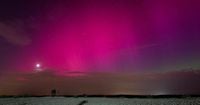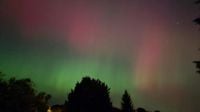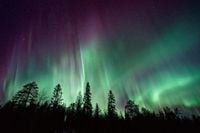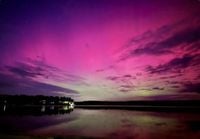A strong geomagnetic storm is expected to bring the chance of the spectacular aurora borealis to Poland on the evening of March 23, 2025. This announcement comes from popular astronomy educator Karol Wójcicki, who details the storm’s potential implications for skywatchers.
Wójcicki reported that the U.S. National Oceanic and Atmospheric Administration (NOAA) continues to uphold its forecast of a strong G3 class geomagnetic storm, which is predicted to hit Earth today. “There is a large chance of seeing the aurora, as all of Poland is within reach!” he enthused in his social media post.
One of the crucial factors for this anticipation is the coronal mass ejection (CME) associated with a relatively weak M1 class solar flare originating from sunspot 4028. Remarkably, as of this morning, the CME had not yet reached Earth, which Wójcicki described as “great news.” The delay in its arrival increases the chances of the CME hitting later in the day, perhaps in the late afternoon or evening, enhancing opportunities for observers to witness the aurora.
Due to the current spring equinox conditions, there are “gaps” created in the Earth’s magnetic field through which solar particles can easily penetrate the atmosphere, a phenomenon known as the Russell-McPherron effect. This means that even a weaker CME could yield spectacular effects tonight.
For those eager to catch a glimpse of this ethereal display, Wójcicki advises looking towards the northern horizon. The best viewing conditions are expected to be found in northern Poland, particularly in regions like Pomerania, Warmia, and northern Mazovia. Unfortunately, forecasts for central and southeastern Poland suggest cloud coverage that could obstruct views of the aurora.
The recommended strategy is to venture away from urban areas where artificial lighting can inhibit visibility. Locations such as open fields, meadows, or forest edges would be ideal spots to set up for viewing. Observers are encouraged to select positions that provide an unobstructed view of the northern sky since that's where the aurora will be most visible.
Wójcicki reminds prospective observers that in Poland, the aurora does not always manifest as the classic “spectacular green curtain” that many might expect. Oftentimes, it appears as a delicate glow or a bright “cloud” that remains stationary. “That’s why it’s worth having a camera that can take long-exposure photos – such equipment will see much more than the naked eye,” he emphasized.
The skies have previously provided glimpses of the aurora borealis in Poland during recent days, delighting skywatchers with their vibrant colors. Images circulating on social media showcase the phenomenon in the northern parts of the country. Wójcicki's predictive outlook further suggests that additional auroral displays may occur as a result of the ongoing solar activity.
As the evening progresses, keen observers will be braving the weather conditions to find the best spots for observing the aurora. Meteorologists predict clearer skies in the northern regions, while central and southern Poland may contend with rain and clouds, making full appreciation of the display challenging. Those planning to gaze skyward should keep these conditions in mind and remain hopeful for a clear view of nature’s stunning light show.
Tonight’s celestial spectacle not only carries with it the beauty that the aurora offers but also serves to highlight the intricate interactions between solar activity and Earth’s atmosphere. Wójcicki encapsulated the essence of the night perfectly: “A weak CME could still yield spectacular effects!” The ghostly green hues of the aurora promise to add a touch of magic to the night sky across Poland, inviting everyone to partake in this natural wonder.









